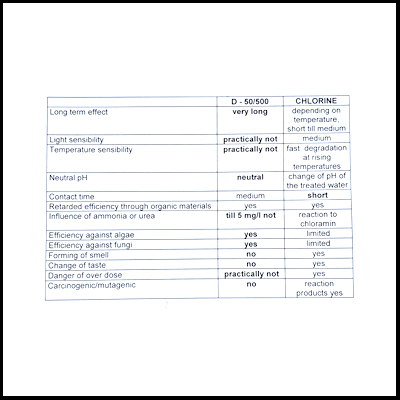











PRODUCT DESCRIPTION
The disinfecting action of Bafry 50/500 is based on hydrogen peroxide and silver. The hydrogen peroxide acts as an oxidant, bound with stabilizers to form a complex solution. The incorporation of silver ions achieves a long-lasting effect. The bactericidal action of silver is based on the fact that the monovalent ion binds firmly to bacterial proteins in a covalent and coordinated manner, with the result that they are inactivated or precipitated.
Hydrogen peroxide (H202) is an oxidizing agent with disinfectant properties. It is also a substance that releases oxygen, transforming itself into pure water (H20), leaving no traces of microelements in the treated water. Hydrogen peroxide is used industrially as a food additive, bleach, and in chemical reactions. It is also used to decontaminate and purify industrial wastewater and stale air. It has the disadvantage of being very unstable with a tendency to decompose itself, in a concentrated manner, making it difficult to use as a disinfectant and not suitable for preventing re-contamination due to its slow and short-lived effectiveness.
Silver (Ag)
The term oligodynamic was invented by the Swiss botanist Carl Von Nägeli in 1880 when he observed that high silver solutions have an algaecide effect. Another important discovery was that the same low concentration also has a bactericidal effect. Silver turned out to have several advantages compared to other disinfectants; "Silver Water" has no odor, does not cause eye irritation, and does not form chloramine or other irritating substances. Silver ions can be dosed in such small quantities that they do not alter the chemical and physical properties of the treated water. Therefore, silver can be used over a very wide pH range, without altering the pH of the treated water. In addition, it proved to be effective at high water temperatures and its long-lasting bacteriostatic effect proved to be excellent, actively preventing recontamination. One disadvantage presented by the oligodynamic effect is that silver does not have an oxidizing effect, so it is not able to decompose, alter or remove organic matter by oxidation. Another disadvantage is its slow bactericidal action. Also, It is only effective in clean water so turbid water must be purified before treatment.
Bafry 50/500 combines these two elements resulting in an impressive intensification of the properties of each of the individual substances. The synergy obtained resulted in excellent disinfection properties at very low concentrations. The silver content in Bafry 50/500 is approximately 10 to 20 times lower than the concentration officially authorized worldwide for drinking water. The combination of oxidation and the oligodynamic effect resulted in a two-phase (multifaceted) product capable of removing biofilm at a normal application concentration (without overdosing). This is a very important aspect in the fight against more developed forms of bacteria and viruses that form so-called biofilms with natural protection. The hydrogen peroxide oxidizes the biofilm, thus allowing an access to the silver to destroy the bacteria or virus without inconvenience.
ADVANTAGES AND FEATURES
- Universal application
- Gap-free effectiveness
- Long-lasting effect
- Prevents recontamination
- No danger of bacterial resistance
- Effective at water temperatures between 0° and 95° Celsius
- Maintains its efficiency and long-lasting effect even at elevated water temperatures.
- No danger in case of overdose
- Does not change the taste and odor of the treated foods.
- No odor
- No rinsing necessary
- No need to neutralize after applying the product
- No chemical combination with other chemicals
- Neutral pH
- Practically harmless to sewage and the environment
- Non-toxic in a diluted state
- Neither carcinogenic or mutagenic
-In a diluted state it does not cause irritation of the skin, eyes, or mucous membranes
-Can be stored for up to 5 years
EFFICIANCY / ANTIMICROBIAL EFFECT
The antimicrobial effect of Bafry 50/500 includes the whole range of microorganisms.
They are effective against:
- Gram-positive bacteria and gram-negative bacteria
- Viruses, including bacteriophages
- Spore-forming organisms
- Yeasts - Molds - Amoebae - Sporagens
- Anthracis, Cholera, ECBO, herpes, hepatitis, AIDS, influenza, avian flu (H5N1, H5, H7, H9), legionella, listeria, meningitis, MRSA, mycoderins, Newcastle disease, poliomyelitis, pseudorabies, tuberculosis, vaccine, VRE, etc.
- Biofilm: Bafry 50/500 is capable of destroying biofilm in normal application concentration (without overdosing) allowing the combination of hydrogen peroxide and silver to destroy the virus or bacteria without any inconvenience.

LIST OF PATHOGENS EXAMINED
Absidia corymbiféra
Acinetobacter Iwoffii
Aeromonas Salmonicida
Agrobacterium radiobacter
Alternaria Alternata
Anthrax (Bacillus Anthracis)
Aspergillus niger
Aspergillus niger-spores
Astenionella Formosa
Bacillus cereus
Bacillus licheniformis
Bacillus mesenterious
Bacillus subtilis
Bacillus subtilis spores
(S.B. Aspergillus fumigates Adenovirus)
Bacillus circulants vegetative and spores
Bacillus sp. Marine
Bacteria cinerea
Bacteria erwinia
Botrytis cinerea
Burkholderia cepacia
Campylobacter jejuni
Candida albicans
CDC gr. IV C-2
Chlamidomonas sp.
Colera (V. cholerae)
Chryseomonas luteola
Chroomonas norstedtii
Ciliata g. sp.
Citro. Fre.
Cladosporium cladosporoides
Clostidrium novyi
Clostidrium perfringens
Clostidrium sporogenes
Coagulase +ve staphylococci
Comomonas acidovorans
Corynebact.
Criptomonas sp.
Dermatophagoides pteronyssinus
ECBO virus
Enterobacter aerogenes
Enterococcus faecium
Enterococcus faecalis
Enterococcus hirae
Erwinia carotovora
Eschericia coli
Flagellata apochromatica
Flavobacter/ Cytophaga
Flavobacterium indologenes
Fragilaria sp.
Fusarium
Fusarium spp.
Galionella sp.
G. Candidum
Hepatitis B
Hepatitis C surrogate (BVDV)
Herpes simplex type 1
HIV-1
Influenza A virus
Influenza A, H5N1
Influenza A, H5, H7 y H9
Klebsiella oxytoca
Klebsiella pneumoniae
Lactobacillus brevis
Lactobacillus lindneri
Lactobacillus plantarum
Lactobacillus sp
Lactobacillus wild type
Legionella pneumophila
Leuconostoc mesenteroides
Listeria innocua
Listeria monocytogenes
Melosira var.
MRSA
Microsporum gypseum
Micrococcus luteus
Micrococci marine
Micrococcus pyogenes aureus
Micrococcus roseus
Micrococcus candidus
Mucor
Mycobacterium phlei
Mycobacterium smegmatis
Mycobacterium spez.
Nagleria fowleri
Naumaniella sp.
Neisseria meningitidis
Newcastle Disease Virus
Nitzschia sp.
Ochrobactrum anthorpi
Orthopoxvirus vaccinia
Papovavirus SV-40
Paramyxo virus
Pasteurella
Pedicoccus damnosus
Pedicoccus sp
Penicillium
Penicillium digitatum
Penicillium roqueforti
Pestis (Y. Pestis)
Pichia membranaefaciens
Poliovirus 1
Proteus mirabilis
Proteus vulgaris
Pseudomonas aeruginosa
Pseudomonas alcaligenes
Pseudomonas chlororaphis
Pseudomonas fluorescens
Pseudomonas spec.
Pseudomonas syringae pv. Tomato
Ralstonia picketti
Rhizopus
Rotatoria g. sp.
Saccaromyces cerevisiae
Saccharomyces uvarum
Sacch.cereivisia var. Uvarum
Ssp.carlsbergensis
Salmonella enteritidis
Salmonella paratyphi
Salmonella sp.
Salmonella typhimurium
Salmonella typhi
Salmonella typhosa
Sarcina lutea
Staphylococcus agalactiae
Staphylococcus albus
Staphylococcus aureus
Staphylococcus faecium
Staphylococcus marcescens
Stephanodiscus hantzschii
Streptococcus faecalis
Streptococcus lactis
Streptococcus pyogenes
Trichophyton mentagrophytes
Pseudorabies virus
Trophozoite protozoa inl. Amoebae
Tuberculosis (Mycobacterium)
Tuberculosis, resistant strain H37 Rv)
Tuberculosis (Mycobacterium
Tuberculosis, wild-type strain)
Vaccina virus
VRE
V.parahaemolyticus
Xanthomonas campestris
Zoogloea sp.







